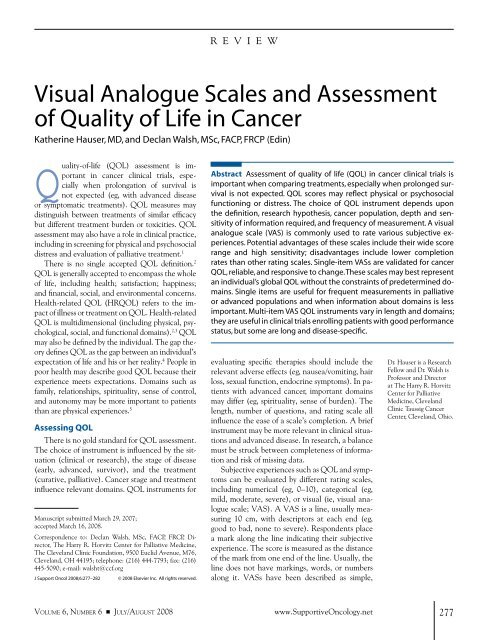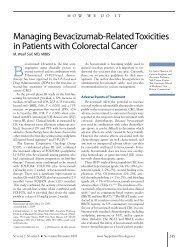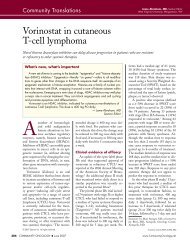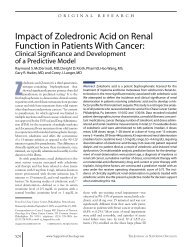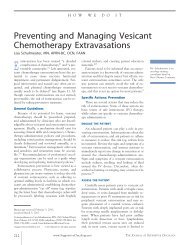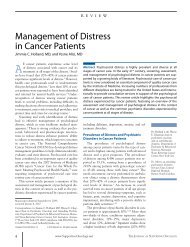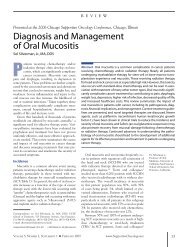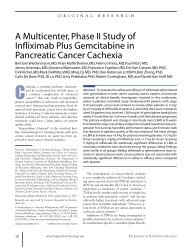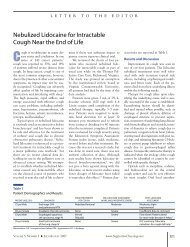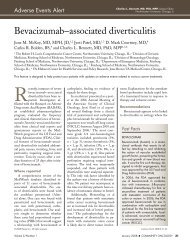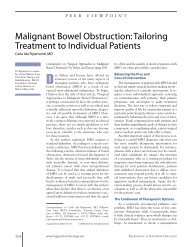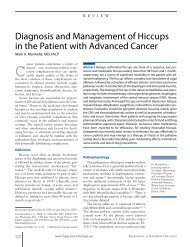Visual Analogue Scales and Assessment of Quality of Life in Cancer
Visual Analogue Scales and Assessment of Quality of Life in Cancer
Visual Analogue Scales and Assessment of Quality of Life in Cancer
You also want an ePaper? Increase the reach of your titles
YUMPU automatically turns print PDFs into web optimized ePapers that Google loves.
J Support Oncol 2008;6:277–282 © 2008 Elsevier Inc. All rights reserved.<br />
review<br />
<strong>Visual</strong> <strong>Analogue</strong> <strong>Scales</strong> <strong>and</strong> <strong>Assessment</strong><br />
<strong>of</strong> <strong>Quality</strong> <strong>of</strong> <strong>Life</strong> <strong>in</strong> <strong>Cancer</strong><br />
Kather<strong>in</strong>e Hauser, MD, <strong>and</strong> Declan Walsh, MSc, FACP, FRCP (Ed<strong>in</strong>)<br />
Q<br />
uality-<strong>of</strong>-life (QOL) assessment is important<br />
<strong>in</strong> cancer cl<strong>in</strong>ical trials, especially<br />
when prolongation <strong>of</strong> survival is<br />
not expected (eg, with advanced disease<br />
or symptomatic treatments). QOL measures may<br />
dist<strong>in</strong>guish between treatments <strong>of</strong> similar efficacy<br />
but different treatment burden or toxicities. QOL<br />
assessment may also have a role <strong>in</strong> cl<strong>in</strong>ical practice,<br />
<strong>in</strong>clud<strong>in</strong>g <strong>in</strong> screen<strong>in</strong>g for physical <strong>and</strong> psychosocial<br />
distress <strong>and</strong> evaluation <strong>of</strong> palliative treatment. 1<br />
There is no s<strong>in</strong>gle accepted QOL def<strong>in</strong>ition. 2<br />
QOL is generally accepted to encompass the whole<br />
<strong>of</strong> life, <strong>in</strong>clud<strong>in</strong>g health; satisfaction; happ<strong>in</strong>ess;<br />
<strong>and</strong> f<strong>in</strong>ancial, social, <strong>and</strong> environmental concerns.<br />
Health-related QOL (HrQOL) refers to the impact<br />
<strong>of</strong> illness or treatment on QOL. Health-related<br />
QOL is multidimensional (<strong>in</strong>clud<strong>in</strong>g physical, psychological,<br />
social, <strong>and</strong> functional doma<strong>in</strong>s). 2,3 QOL<br />
may also be def<strong>in</strong>ed by the <strong>in</strong>dividual. The gap theory<br />
def<strong>in</strong>es QOL as the gap between an <strong>in</strong>dividual’s<br />
expectation <strong>of</strong> life <strong>and</strong> his or her reality. 4 People <strong>in</strong><br />
poor health may describe good QOL because their<br />
experience meets expectations. Doma<strong>in</strong>s such as<br />
family, relationships, spirituality, sense <strong>of</strong> control,<br />
<strong>and</strong> autonomy may be more important to patients<br />
than are physical experiences. 5<br />
Assess<strong>in</strong>g QOL<br />
There is no gold st<strong>and</strong>ard for QOL assessment.<br />
The choice <strong>of</strong> <strong>in</strong>strument is <strong>in</strong>fluenced by the situation<br />
(cl<strong>in</strong>ical or research), the stage <strong>of</strong> disease<br />
(early, advanced, survivor), <strong>and</strong> the treatment<br />
(curative, palliative). <strong>Cancer</strong> stage <strong>and</strong> treatment<br />
<strong>in</strong>fluence relevant doma<strong>in</strong>s. QOL <strong>in</strong>struments for<br />
Manuscript submitted March 29, 2007;<br />
accepted March 16, 2008.<br />
Correspondence to: Declan walsh, MSc, FACP, FrCP, Director,<br />
The Harry r. Horvitz Center for Palliative Medic<strong>in</strong>e,<br />
The Clevel<strong>and</strong> Cl<strong>in</strong>ic Foundation, 9500 euclid Avenue, M76,<br />
Clevel<strong>and</strong>, OH 44195; telephone: (216) 444-7793; fax: (216)<br />
445-5090; e-mail: walsht@ccf.org<br />
Abstract <strong>Assessment</strong> <strong>of</strong> quality <strong>of</strong> life (QOL) <strong>in</strong> cancer cl<strong>in</strong>ical trials is<br />
important when compar<strong>in</strong>g treatments, especially when prolonged survival<br />
is not expected. QOL scores may reflect physical or psychosocial<br />
function<strong>in</strong>g or distress. The choice <strong>of</strong> QOL <strong>in</strong>strument depends upon<br />
the def<strong>in</strong>ition, research hypothesis, cancer population, depth <strong>and</strong> sensitivity<br />
<strong>of</strong> <strong>in</strong>formation required, <strong>and</strong> frequency <strong>of</strong> measurement. A visual<br />
analogue scale (VAS) is commonly used to rate various subjective experiences.<br />
Potential advantages <strong>of</strong> these scales <strong>in</strong>clude their wide score<br />
range <strong>and</strong> high sensitivity; disadvantages <strong>in</strong>clude lower completion<br />
rates than other rat<strong>in</strong>g scales. S<strong>in</strong>gle-item VASs are validated for cancer<br />
QOL, reliable, <strong>and</strong> responsive to change. These scales may best represent<br />
an <strong>in</strong>dividual’s global QOL without the constra<strong>in</strong>ts <strong>of</strong> predeterm<strong>in</strong>ed doma<strong>in</strong>s.<br />
S<strong>in</strong>gle items are useful for frequent measurements <strong>in</strong> palliative<br />
or advanced populations <strong>and</strong> when <strong>in</strong>formation about doma<strong>in</strong>s is less<br />
important. Multi-item VAS QOL <strong>in</strong>struments vary <strong>in</strong> length <strong>and</strong> doma<strong>in</strong>s;<br />
they are useful <strong>in</strong> cl<strong>in</strong>ical trials enroll<strong>in</strong>g patients with good performance<br />
status, but some are long <strong>and</strong> disease-specific.<br />
evaluat<strong>in</strong>g specific therapies should <strong>in</strong>clude the<br />
relevant adverse effects (eg, nausea/vomit<strong>in</strong>g, hair<br />
loss, sexual function, endocr<strong>in</strong>e symptoms). <strong>in</strong> patients<br />
with advanced cancer, important doma<strong>in</strong>s<br />
may differ (eg, spirituality, sense <strong>of</strong> burden). The<br />
length, number <strong>of</strong> questions, <strong>and</strong> rat<strong>in</strong>g scale all<br />
<strong>in</strong>fluence the ease <strong>of</strong> a scale’s completion. A brief<br />
<strong>in</strong>strument may be more relevant <strong>in</strong> cl<strong>in</strong>ical situations<br />
<strong>and</strong> advanced disease. <strong>in</strong> research, a balance<br />
must be struck between completeness <strong>of</strong> <strong>in</strong>formation<br />
<strong>and</strong> risk <strong>of</strong> miss<strong>in</strong>g data.<br />
Subjective experiences such as QOL <strong>and</strong> symptoms<br />
can be evaluated by different rat<strong>in</strong>g scales,<br />
<strong>in</strong>clud<strong>in</strong>g numerical (eg, 0–10), categorical (eg,<br />
mild, moderate, severe), or visual (ie, visual analogue<br />
scale; vAS). A vAS is a l<strong>in</strong>e, usually measur<strong>in</strong>g<br />
10 cm, with descriptors at each end (eg,<br />
good to bad, none to severe). respondents place<br />
a mark along the l<strong>in</strong>e <strong>in</strong>dicat<strong>in</strong>g their subjective<br />
experience. The score is measured as the distance<br />
<strong>of</strong> the mark from one end <strong>of</strong> the l<strong>in</strong>e. Usually, the<br />
l<strong>in</strong>e does not have mark<strong>in</strong>gs, words, or numbers<br />
along it. vASs have been described as simple,<br />
Vo l u m e 6, Nu m b e r 6 ■ Ju ly/Au g u s t 2008 www.SupportiveOncology.net<br />
Dr. Hauser is a research<br />
Fellow <strong>and</strong> Dr. walsh is<br />
Pr<strong>of</strong>essor <strong>and</strong> Director<br />
at The Harry r. Horvitz<br />
Center for Palliative<br />
Medic<strong>in</strong>e, Clevel<strong>and</strong><br />
Cl<strong>in</strong>ic Taussig <strong>Cancer</strong><br />
Center, Clevel<strong>and</strong>, Ohio.<br />
277
<strong>Visual</strong> <strong>Analogue</strong> <strong>Scales</strong> <strong>and</strong> <strong>Assessment</strong> <strong>of</strong> <strong>Quality</strong> <strong>of</strong> <strong>Life</strong> <strong>in</strong> <strong>Cancer</strong><br />
Worst imag<strong>in</strong>able<br />
quality <strong>of</strong> life<br />
<strong>Life</strong> is not worth liv<strong>in</strong>g<br />
<strong>Life</strong> could not be better<br />
Perfect<br />
quality <strong>of</strong> life<br />
How are you do<strong>in</strong>g overall today?<br />
Worst possible Best possible<br />
How would you rate your well-be<strong>in</strong>g today?<br />
Very low Very high<br />
How would you rate your quality <strong>of</strong> life today?<br />
Very low Very high<br />
Figure 1 Examples <strong>of</strong> Global <strong>Quality</strong>-<strong>of</strong>-<strong>Life</strong><br />
<strong>Visual</strong> <strong>Analogue</strong> Scale<br />
highly sensitive, <strong>and</strong> reliable rat<strong>in</strong>g scales for subjective experiences.<br />
6 The ma<strong>in</strong> advantage <strong>of</strong> a vAS is that respondents<br />
may <strong>in</strong>dicate any place along the l<strong>in</strong>e rather than be restricted<br />
by categories or numbers.<br />
vASs have been used to assess cancer QOL s<strong>in</strong>ce 1976. 7<br />
This article aims to review the role <strong>of</strong> vASs <strong>in</strong> the evaluation<br />
<strong>of</strong> cancer QOL <strong>and</strong> the methodologic issues associated with<br />
their use.<br />
VASs for QOL <strong>of</strong> <strong>Cancer</strong> Patients<br />
vASs for QOL <strong>of</strong> cancer patients may be s<strong>in</strong>gle-item, global<br />
questions (eg, how is your QOL?) or multi-item scales. Multiitem<br />
scales <strong>in</strong>clude <strong>in</strong>dividual questions about many doma<strong>in</strong>s <strong>of</strong><br />
QOL (eg, symptoms, function, relationships) <strong>and</strong> may also <strong>in</strong>clude<br />
a global scale. These scales <strong>of</strong>ten have a summated score<br />
represent<strong>in</strong>g overall QOL <strong>and</strong> may have several subscale scores.<br />
S<strong>in</strong>gle-item vASs for QOL have been suggested to best represent<br />
<strong>in</strong>dividual QOL because they do not constra<strong>in</strong> responses to<br />
the doma<strong>in</strong>s determ<strong>in</strong>ed by health care providers. 5<br />
SINGLE-ITEM VASs FOR QOL<br />
Several s<strong>in</strong>gle-item vASs for QOL have been validated<br />
<strong>in</strong> oncology. They vary <strong>in</strong> design (Figure 1), with descriptors<br />
<strong>in</strong>clud<strong>in</strong>g general well-be<strong>in</strong>g, 8 life not worth liv<strong>in</strong>g, 9 physical<br />
well-be<strong>in</strong>g, 10 cop<strong>in</strong>g, 11 <strong>and</strong> QOL. 12,13 S<strong>in</strong>gle-item QOL vASs<br />
correlate well with multidimensional questionnaires. 8,9,11–14<br />
Test-retest8,12 <strong>and</strong> <strong>in</strong>terrater13 reliability have also been demonstrated.<br />
vASs are responsive to chemotherapy-related<br />
changes over time <strong>and</strong> global rat<strong>in</strong>gs <strong>of</strong> change. 10,12 S<strong>in</strong>gle-item<br />
vASs have shown improved QOL with pa<strong>in</strong> relief, 15,16 stable<br />
QOL <strong>in</strong> patients <strong>in</strong> hospice care, 17 <strong>and</strong> response to structured<br />
<strong>in</strong>tervention dur<strong>in</strong>g radiotherapy. 18<br />
One issue with s<strong>in</strong>gle-item vASs is whether a multidimensional<br />
concept like QOL can be captured <strong>in</strong> a s<strong>in</strong>gle l<strong>in</strong>e.<br />
S<strong>in</strong>gle-item scales do not evaluate the doma<strong>in</strong>s contribut<strong>in</strong>g<br />
to QOL <strong>and</strong> thus provide no <strong>in</strong>formation expla<strong>in</strong><strong>in</strong>g the overall<br />
rat<strong>in</strong>g. However, many multidimensional <strong>in</strong>struments rely<br />
on experts to determ<strong>in</strong>e doma<strong>in</strong>s <strong>and</strong> their weight<strong>in</strong>g; they<br />
may not truly represent doma<strong>in</strong>s important to an <strong>in</strong>dividual.<br />
S<strong>in</strong>gle-item scales leave the def<strong>in</strong>ition <strong>of</strong> QOL to the <strong>in</strong>dividual<br />
respondent.<br />
<strong>in</strong> hospice care, s<strong>in</strong>gle-item QOL correlated well with cognitive,<br />
physical, <strong>and</strong> spiritual well-be<strong>in</strong>g <strong>and</strong> social activity but<br />
not with social support. 18 Similarly, the eOrTC (european<br />
Organization for research <strong>and</strong> Treatment <strong>of</strong> <strong>Cancer</strong>) QLQ-<br />
C30 (<strong>Quality</strong>-<strong>of</strong>-<strong>Life</strong> Questionnaire Core 30) global QOL<br />
subscale (numerical) correlated moderately with physical, role,<br />
cognitive, emotional, <strong>and</strong> social function<strong>in</strong>g; fatigue; <strong>and</strong> pa<strong>in</strong><br />
doma<strong>in</strong>s but less with nausea <strong>and</strong> vomit<strong>in</strong>g. 19 The mean<strong>in</strong>g<br />
<strong>of</strong> the term “QOL” may vary by age, culture, education, <strong>and</strong><br />
language. Global <strong>in</strong>dicators (eg, treatment burden) may allow<br />
a comparison between different treatments across trials. 20,21<br />
The Spitzer Uniscale. The Spitzer Uniscale is a s<strong>in</strong>gle question:<br />
“Please rate your overall QOL.” 22,23 Orig<strong>in</strong>ally designed<br />
for physician rat<strong>in</strong>g, it is now used for both patient <strong>and</strong> observer<br />
QOL rat<strong>in</strong>gs. 23 The Spitzer Uniscale is valid, with moderate to<br />
high correlations with multidimensional QOL measures; it is<br />
sensitive to changes <strong>in</strong> performance status, symptoms, <strong>and</strong> progressive<br />
disease <strong>and</strong> correlates with survival. 23 Physician scores<br />
agree moderately with patients’ scores, although they tend to<br />
underestimate QOL. The completion rate is above 90%.<br />
respondents mark an X <strong>in</strong> a box with anchors “lowest<br />
quality to highest quality.” The orig<strong>in</strong>al Uniscale description<br />
did not specify the length <strong>of</strong> the box, nor where on the X the<br />
score was measured. Scor<strong>in</strong>g has been described as either 0–14<br />
or 0–100. Some authors adapted it to a s<strong>in</strong>gle-l<strong>in</strong>e vAS with<br />
the same anchors.<br />
MULTI-ITEM VASS FOR QOL<br />
Multiple-item vASs for cancer QOL were first described <strong>in</strong><br />
1976. 7 Ten horizontal vASs assessed physical <strong>and</strong> psychological<br />
symptoms, activity, social <strong>and</strong> role activities, <strong>and</strong> well-be<strong>in</strong>g.<br />
Scores were responsive to treatment <strong>and</strong> toxicity. Several<br />
multidimensional vAS QOL <strong>in</strong>struments have between 8 <strong>and</strong><br />
53 items. They may be general (eg, GLQ824 ) or disease-specific<br />
(Lung <strong>Cancer</strong> Symptom Scale [LCSS] 25,26 or the Prostate <strong>Cancer</strong><br />
Specific QOL <strong>in</strong>strument [PrOSQOLi]). 27–29 Although<br />
doma<strong>in</strong>s vary, they all assess pa<strong>in</strong> <strong>and</strong> appetite but less <strong>of</strong>ten<br />
nausea <strong>and</strong> fatigue. Many are lengthy, limit<strong>in</strong>g their usefulness<br />
to cl<strong>in</strong>ical trials, <strong>and</strong> are not relevant for advanced cancer or<br />
palliative populations. Completion rates are <strong>in</strong>frequently reported.<br />
when reported, they are high (80%–90%). 24,30 Family<br />
is important <strong>in</strong> the QOL <strong>of</strong> cancer patients but <strong>in</strong>frequently<br />
assessed. Similarly, spirituality is assessed <strong>in</strong> only one multi-<br />
278 www.SupportiveOncology.net th e Jo u r N A l o f su p p o rt i V e oN c o l o g y
Table 1<br />
Multi-item <strong>Quality</strong>-<strong>of</strong>-<strong>Life</strong> <strong>Visual</strong> <strong>Analogue</strong> Scale<br />
dimensional questionnaire (the QOL-rTi [QOL-radiation<br />
Therapy <strong>in</strong>strument], which has subsequently changed to a<br />
numerical format). 31<br />
General scales. General vAS <strong>in</strong>struments are described <strong>in</strong><br />
Table 1. 7,24–26,28–40 Many <strong>in</strong>clude a s<strong>in</strong>gle-item overall QOL<br />
scale or a summated score.<br />
Lung cancer. The self-reported LCSS has six symptom (appetite<br />
loss, cough, dyspnea, fatigue, hemoptysis, pa<strong>in</strong>) <strong>and</strong> three<br />
summary scales (symptom distress, normal activity, <strong>and</strong> overall<br />
QOL). 25,26,39,40 An observer scale rates the six symptoms on ord<strong>in</strong>al<br />
scales. it is well validated by correlations with other <strong>in</strong>-<br />
struments <strong>and</strong> performance status <strong>and</strong> has <strong>in</strong>ternal consistency<br />
as well as test-retest <strong>and</strong> <strong>in</strong>terrater reliability. responsiveness<br />
has not been tested. Numerical <strong>and</strong> mesothelioma scales have<br />
been validated. 41,42 The mean completion time is 8 m<strong>in</strong>utes for<br />
patients <strong>and</strong> 2 m<strong>in</strong>utes for observers. The LCSS reflected the<br />
benefit <strong>of</strong> docetaxel (Taxotere) chemotherapy over v<strong>in</strong>orelb<strong>in</strong>e<br />
or best supportive care <strong>in</strong> advanced lung cancer 43,44 <strong>and</strong> better<br />
QOL <strong>in</strong> non smokers. 45 The appetite <strong>and</strong> fatigue subscales<br />
<strong>in</strong>dependently predict survival. 46 The LCSS is computerized for<br />
h<strong>and</strong>-held devices, is easy to use, <strong>and</strong> is able to enhance communication<br />
<strong>and</strong> satisfaction with cl<strong>in</strong>ic visits. 47<br />
Vo l u m e 6, Nu m b e r 6 ■ Ju ly/Au g u s t 2008 www.SupportiveOncology.net<br />
Hauser <strong>and</strong> Walsh<br />
AUTHOR OR<br />
INSTRUMENT DESIGN DOMAINS PSYCHOMETRICS<br />
Priestman <strong>and</strong> Baum7,32 10 horizontal VASs Well-be<strong>in</strong>g, mood, activity, pa<strong>in</strong>, nausea, Responsive to change with chemotherapy,<br />
(1976, 1983) appetite, housework, social activities, endocr<strong>in</strong>e therapy<br />
anxiety, treatment response Test-retest reliability at 24 hours<br />
Padilla et al33 14 horizontal VASs General physical condition (pa<strong>in</strong>, appetite, Discrim<strong>in</strong>ates <strong>in</strong>patient/outpatient,<br />
(1983) nausea, strength) analgesic use<br />
Important activities Internal consistency<br />
Overall QOL Test-retest reliability<br />
Selby et al34–36 29 horizontal VASs 5-factor structure: physical activities, Correlations with SIP, KPS<br />
(1984, 1988, 1992) emotional, alimentary, appearance, Discrim<strong>in</strong>ates metastatic disease/early,<br />
<strong>and</strong> concentration <strong>and</strong> language chemotherapy or not<br />
Holmes <strong>and</strong> Dickerson<br />
Internal consistency<br />
Test-retest reliability at 9–12 hours<br />
Interrater reliability<br />
37 26 horizontal VASs Symptoms, 11 items Discrim<strong>in</strong>ates <strong>in</strong>patient vs outpatient<br />
(1987) Activities <strong>of</strong> daily liv<strong>in</strong>g, 15 items Internal reliability<br />
Test-retest reliability at 1 hour<br />
Coates et al 8 horizontal VASs Physical symptoms: pa<strong>in</strong>, fatigue, Correlations with FLIC, PACIS, PAC<br />
GLQ824 appetite/sense <strong>of</strong> taste, nausea/vomit<strong>in</strong>g, Discrim<strong>in</strong>ates chemotherapy <strong>and</strong><br />
(1990) hair loss numbness/p<strong>in</strong>s <strong>and</strong> needles performance status<br />
Anxiety, depression, sexual <strong>in</strong>terest<br />
Thought <strong>of</strong> hav<strong>in</strong>g treatment<br />
Global QOL<br />
Test-retest reliability at 1 <strong>and</strong> 24 hours<br />
Ballatori et al38 49 items, 10 cm horizontal 3 factors: psychological, relationship to Discrim<strong>in</strong>ates performance status<br />
(1993) VASs hospital, <strong>and</strong> appetite Test-retest reliability at 24 hours<br />
Hollen et al Patient scale: 9 horizontal 6 symptoms: appetite loss, cough, dyspnea, Correlates with KPS, SIP, POMS<br />
LCSS25,26,39,40 VASs fatigue, hemoptysis, pa<strong>in</strong> Discrim<strong>in</strong>ates performance status, cancer<br />
(1993, 1994, 1999) Observer scale: 6 symptoms 3 summary scales: symptom distress, stage<br />
(ord<strong>in</strong>al scale) normal activity, <strong>and</strong> overall QOL Internal reliability<br />
Each item on a separate card Test-retest reliability at 1 hour<br />
Modified <strong>and</strong> validated for mesothelioma41 Numerical form validated42 Johnson et al 24 horizontal VASs 4 doma<strong>in</strong>s: functional/health, Correlates with FPQLI<br />
QOL-RTI31 socioeconomic/family, general QOL, Internal consistency<br />
(1994) emotional/psychological<br />
Subsequently, scal<strong>in</strong>g changed to<br />
numerical 0–10, <strong>and</strong> head <strong>and</strong> neck<br />
module added<br />
Test-retest reliability at 1 week<br />
Tannock et al, 9 horizontal VASs Physical symptoms (appetite, constipation, Correlates with EORTC QLQ-C30<br />
Stockler et al fatigue, pa<strong>in</strong>, pass<strong>in</strong>g ur<strong>in</strong>e, physical Discrim<strong>in</strong>ates performance status,<br />
PROSQOLI28–30 activity), mood, family, <strong>and</strong> global hemoglob<strong>in</strong> level, analgesic score, <strong>and</strong><br />
(1996, 1998, 1999) well-be<strong>in</strong>g survival<br />
Responsive to treatment<br />
Abbreviations: EORTC QLQ-C30 = European Organization for Research <strong>and</strong> Treatment <strong>of</strong> <strong>Cancer</strong> <strong>Quality</strong>-<strong>of</strong>-<strong>Life</strong> Questionnaire C30; FLIC = Functional Liv<strong>in</strong>g Index–<strong>Cancer</strong>; FPQLI = Ferrans <strong>and</strong><br />
Powers <strong>Quality</strong> <strong>of</strong> <strong>Life</strong> Index; KPS = Karn<strong>of</strong>sky Performance Status; LCSS = Lung <strong>Cancer</strong> Symptom Scale; PAC = Psychological Adjustment to <strong>Cancer</strong> Scale; PACIS = Perceived Adjustment to Chronic<br />
Illness Scale; POMS = Pr<strong>of</strong>ile <strong>of</strong> Mood States; PROSQOLI = Prostate <strong>Cancer</strong> Specific <strong>Quality</strong> <strong>of</strong> <strong>Life</strong> Instrument; QOL = quality <strong>of</strong> life; QOL-RTI = <strong>Quality</strong> <strong>of</strong> <strong>Life</strong>-Radiation Therapy Instrument; SIP =<br />
Sickness Impact Pr<strong>of</strong>ile; VAS = visual analogue scale<br />
279
<strong>Visual</strong> <strong>Analogue</strong> <strong>Scales</strong> <strong>and</strong> <strong>Assessment</strong> <strong>of</strong> <strong>Quality</strong> <strong>of</strong> <strong>Life</strong> <strong>in</strong> <strong>Cancer</strong><br />
Prostate cancer. The PrOSQOLi has n<strong>in</strong>e vASs assess<strong>in</strong>g<br />
physical symptoms (appetite, constipation, fatigue, pa<strong>in</strong>,<br />
pass<strong>in</strong>g ur<strong>in</strong>e, physical activity), mood, family, <strong>and</strong> global<br />
well-be<strong>in</strong>g. 29,30 items correlate moderately with the eOrTC<br />
QLQ-C30. it discrim<strong>in</strong>ates patients by performance status,<br />
hemoglob<strong>in</strong> level, analgesic score, <strong>and</strong> survival. it has demonstrated<br />
improved overall QOL <strong>in</strong> advanced hormone-refractory<br />
prostate cancer patients who responded to mitoxantrone<br />
<strong>and</strong> prednisolone. 30<br />
PROXY MEASURES OF QOL<br />
A vAS may also be used to evaluate specific doma<strong>in</strong>s <strong>of</strong><br />
QOL (eg, <strong>in</strong>dividual symptoms or psychological concerns).<br />
S<strong>in</strong>gle-item VASs. S<strong>in</strong>gle-item vASs are valid for assessment<br />
<strong>of</strong> pa<strong>in</strong> <strong>and</strong> depression <strong>in</strong> cancer. 48,49 They are useful <strong>in</strong> cl<strong>in</strong>ical<br />
trials when change <strong>in</strong> <strong>in</strong>dividual symptoms is expected. They<br />
may be paired with a s<strong>in</strong>gle-item QOL scale to <strong>in</strong>vestigate the<br />
impact <strong>of</strong> symptoms on overall QOL. 15<br />
Edmonton Symptom <strong>Assessment</strong> Scale (ESAS). The eSAS<br />
was designed for palliative populations. N<strong>in</strong>e vASs evaluate<br />
symptoms (activity, anxiety, appetite, depression, drows<strong>in</strong>ess,<br />
pa<strong>in</strong>, nausea, shortness <strong>of</strong> breath, <strong>and</strong> well-be<strong>in</strong>g); scores are<br />
summated to a distress score. 50 it is valid with <strong>in</strong>ternal consistency<br />
<strong>and</strong> test-retest reliability. 51 <strong>in</strong>terrater studies reveal an<br />
overestimation <strong>of</strong> symptoms by caregivers <strong>and</strong> an underestimation<br />
<strong>of</strong> symptoms by physicians. 50,52 The completion rates<br />
vary by stage <strong>of</strong> disease. Most general oncology patients can<br />
complete it on hospital admission, compared with 63%–84%<br />
<strong>of</strong> palliative medic<strong>in</strong>e cancer patients <strong>and</strong> only 15% <strong>of</strong> term<strong>in</strong>al<br />
patients. 50,51,53 rout<strong>in</strong>e use <strong>of</strong> eSAS on admission to a<br />
palliative medic<strong>in</strong>e unit has shown significant underassessment<br />
<strong>and</strong> documentation <strong>of</strong> symptoms, especially <strong>in</strong>activity,<br />
impaired well-be<strong>in</strong>g, <strong>and</strong> anxiety. 54<br />
The Distress Thermometer. The Distress Thermometer is a<br />
modified vAS: a vertical thermometer numbered 0–10 with<br />
the words no distress, moderate distress, <strong>and</strong> severe distress<br />
along the scale. 55–57 it has a 34-item problem checklist, <strong>in</strong>clud<strong>in</strong>g<br />
physical <strong>and</strong> psychosocial concerns. it is validated<br />
<strong>in</strong> cancer populations <strong>and</strong> advocated for rout<strong>in</strong>e screen<strong>in</strong>g. 58<br />
Scores <strong>of</strong> at least 4 are recommended as the trigger for further<br />
evaluation <strong>and</strong> <strong>in</strong>tervention. There is no evidence as to the<br />
association between Distress Thermometer scores <strong>and</strong> QOL<br />
or cl<strong>in</strong>ical outcomes from rout<strong>in</strong>e screen<strong>in</strong>g.<br />
Methodologic Issues<br />
Many studies validat<strong>in</strong>g QOL <strong>in</strong>struments are convenience<br />
or cl<strong>in</strong>ical trial samples. This fact potentially limits the relevance<br />
<strong>of</strong> these <strong>in</strong>struments to selected populations. Other<br />
methodologic issues <strong>in</strong>clude the potential for measurement<br />
error <strong>and</strong> their unsuitability for telephone follow-up. Scor<strong>in</strong>g<br />
a vAS requires measurement rather than simply read<strong>in</strong>g from<br />
a paper, potentially add<strong>in</strong>g a source <strong>of</strong> error. vAS questionnaires<br />
must be pr<strong>in</strong>ted <strong>in</strong>dividually, as photocopy<strong>in</strong>g can distort<br />
the length <strong>of</strong> the l<strong>in</strong>e, lead<strong>in</strong>g to <strong>in</strong>consistent scor<strong>in</strong>g. A<br />
vAS can be computerized, thereby avoid<strong>in</strong>g such difficulties.<br />
At this time, however, only the LCSS has reported results with<br />
an electronic version. 47<br />
Consensus is lack<strong>in</strong>g about the statistical analysis <strong>of</strong> vAS<br />
data. 59,60 issues <strong>in</strong>volve whether the data are ord<strong>in</strong>al or ratio<br />
<strong>and</strong> whether scores are normally distributed <strong>and</strong> thus applicable<br />
for parametric analysis. Comparison <strong>of</strong> parametric (with<br />
<strong>and</strong> without transformation) <strong>and</strong> nonparametric analysis <strong>of</strong><br />
vAS pa<strong>in</strong> scores suggested that parametric tests were accurate<br />
<strong>and</strong> had the greatest power to detect a difference, despite<br />
a lack <strong>of</strong> normal distribution <strong>of</strong> the data. 61<br />
COMPLETION RATES<br />
Completion <strong>of</strong> a vAS requires conceptualization <strong>of</strong> a complex<br />
experience to a s<strong>in</strong>gle l<strong>in</strong>e. vAS pa<strong>in</strong> scales have lower<br />
completion rates than numerical or categorical scales. 62,63<br />
rates are adversely affected by <strong>in</strong>creas<strong>in</strong>g age, higher opioid<br />
dose, <strong>and</strong> the presence <strong>of</strong> confusion. 62,63 Tra<strong>in</strong><strong>in</strong>g <strong>in</strong> vAS technique<br />
is more time-consum<strong>in</strong>g than for other rat<strong>in</strong>g scales. 64<br />
<strong>in</strong> QOL studies, the Uniscale has a similar completion rate to<br />
other multi-item <strong>in</strong>struments. 23 Both the PrOSQOLi28 <strong>and</strong><br />
LCSS43 have high completion rates (> 80%) <strong>in</strong> cl<strong>in</strong>ical trials.<br />
The eSAS completion rate decl<strong>in</strong>es with advanc<strong>in</strong>g disease.<br />
SENSITIVITY<br />
vASs are said to be more sensitive to subjective changes<br />
than are numerical or categorical scales. However, it is unclear<br />
whether such high sensitivity is cl<strong>in</strong>ically relevant. Studies <strong>of</strong><br />
QOL <strong>in</strong> cardiac <strong>and</strong> respiratory failure have demonstrated<br />
a 7-po<strong>in</strong>t verbal descriptor scale had equal sensitivity to a<br />
vAS. 64,65 validation <strong>of</strong> a 0–10 numerical LCSS demonstrated<br />
good agreement with a vAS. 42 Comparison <strong>of</strong> a vAS <strong>in</strong><br />
the PrOSQOLi with equivalent Likert scales <strong>of</strong> the eOrTC<br />
QLQ-C30 demonstrated superior sensitivity <strong>of</strong> the vAS for<br />
pa<strong>in</strong> <strong>and</strong> other physical symptoms. 28 All scales differentiated<br />
treatment groups, but the vAS was less sensitive <strong>in</strong> complex<br />
doma<strong>in</strong>s like family <strong>and</strong> emotional function.<br />
CLINICAL SIGNIFICANCE<br />
Small changes on a vAS (eg, 0–5 mm) may be statistically<br />
significant but cl<strong>in</strong>ically irrelevant. The cl<strong>in</strong>ical significance<br />
can be evaluated by compar<strong>in</strong>g vAS scores with a global<br />
change scale (eg, from much better to much worse). For acute<br />
pa<strong>in</strong>, the m<strong>in</strong>imal cl<strong>in</strong>ically significant vAS change is 13<br />
mm. 66 <strong>in</strong>direct LCSS analysis supported cl<strong>in</strong>ically significant<br />
changes <strong>of</strong> 10–25 mm. 67 Cl<strong>in</strong>ically significant change has been<br />
suggested as 50% <strong>of</strong> the scale’s st<strong>and</strong>ard deviation (ie, 8–10<br />
mm on a 100-mm vAS). 21 This result would be equivalent to<br />
a change <strong>of</strong> 1 on an 11-po<strong>in</strong>t numerical scale.<br />
Instrument Selection<br />
Several factors affect the selection <strong>of</strong> an <strong>in</strong>strument. Population<br />
characteristics (<strong>in</strong>clud<strong>in</strong>g age, diagnosis, <strong>and</strong> performance<br />
status) affect completion rates <strong>and</strong> whether a diseasespecific<br />
or general questionnaire is appropriate. <strong>in</strong> research,<br />
the def<strong>in</strong>ition <strong>and</strong> hypothesis <strong>in</strong>fluence this choice, particu-<br />
280 www.SupportiveOncology.net th e Jo u r N A l o f su p p o rt i V e oN c o l o g y
larly whether global QOL or specific doma<strong>in</strong>s are important<br />
or likely to change with <strong>in</strong>tervention.<br />
The choice <strong>of</strong> scale (vAS, numerical, or categorical) depends<br />
upon the data sensitivity required <strong>and</strong> the desired<br />
completion rates. <strong>in</strong>struments that appear to be relevant to<br />
cl<strong>in</strong>ical practice <strong>in</strong>clude s<strong>in</strong>gle-item global scales (QOL, treatment<br />
burden), the eSAS, the Distress Thermometer, <strong>and</strong> the<br />
LCSS. <strong>in</strong>struments with numerical or categorical scales may<br />
be easier to complete <strong>and</strong> score, <strong>and</strong> changes may be more<br />
relevant to cl<strong>in</strong>ical practice. Measurement frequency is important;<br />
s<strong>in</strong>gle-item vASs may be useful for frequent measures<br />
<strong>and</strong> may avoid patient burden. S<strong>in</strong>gle-item QOL <strong>in</strong>struments<br />
may be worthwhile <strong>in</strong> cl<strong>in</strong>ical trials (especially longitud<strong>in</strong>al<br />
ones) for cl<strong>in</strong>ical screen<strong>in</strong>g (pa<strong>in</strong>, depression, advanced cancer)<br />
<strong>and</strong> for global QOL. 13 <strong>in</strong> symptom relief trials, comb<strong>in</strong><strong>in</strong>g<br />
symptom <strong>and</strong> s<strong>in</strong>gle-item QOL vASs assesses the impact <strong>of</strong><br />
symptoms on QOL. S<strong>in</strong>gle items are relevant <strong>and</strong> may best<br />
represent what the patient is experienc<strong>in</strong>g. whether the score<br />
range 0–100 is necessary is debatable; perhaps a score range <strong>of</strong><br />
only 0–10 is needed.<br />
Future Research<br />
Clarification <strong>of</strong> the ideal rat<strong>in</strong>g scales for QOL is neces-<br />
References<br />
PubMed ID <strong>in</strong> brackets<br />
1. Sloan JA, Frost MH, Berzon R, et al. The cl<strong>in</strong>ical<br />
significance <strong>of</strong> quality <strong>of</strong> life assessments <strong>in</strong> oncology:<br />
a summary for cl<strong>in</strong>icians. Support Care <strong>Cancer</strong><br />
2006;14:988–998. [1679481]<br />
2. Ferrans CE. Def<strong>in</strong>itions <strong>and</strong> conceptual models<br />
<strong>of</strong> quality <strong>of</strong> life. In: Lipscomb J, Gotay C, Snyder C, eds.<br />
Outcomes <strong>Assessment</strong> <strong>in</strong> <strong>Cancer</strong>. Measures, Methods<br />
<strong>and</strong> Applications. Cambridge, UK: Cambridge<br />
University Press; 2005:14–30.<br />
3. Wilson IB, Cleary PD. L<strong>in</strong>k<strong>in</strong>g cl<strong>in</strong>ical variables<br />
with health-related quality <strong>of</strong> life: a conceptual<br />
model <strong>of</strong> patient outcomes. JAMA 1995;273:59–65.<br />
[7996652]<br />
4. Calman KC. <strong>Quality</strong> <strong>of</strong> life <strong>in</strong> cancer patients—<br />
an hypothesis. J Med Ethics 1984;10:124–127.<br />
[6334159]<br />
5. McCabe C, Begley C, Collier S, McCann S.<br />
Methodological issues related to assess<strong>in</strong>g <strong>and</strong><br />
measur<strong>in</strong>g quality <strong>of</strong> life <strong>in</strong> patients with cancer:<br />
implications for patient care. Eur J <strong>Cancer</strong> Care (Engl)<br />
2008;17:56–64. [18181892]<br />
6. McCormack HM, Horne DJ, Sheather S. Cl<strong>in</strong>ical<br />
applications <strong>of</strong> visual analogue scales: a critical review.<br />
Psychol Med 1988;18:1007–1019. [3078045]<br />
7. Priestman TJ, Baum M. Evaluation <strong>of</strong> quality<br />
<strong>of</strong> life <strong>in</strong> patients receiv<strong>in</strong>g treatment for advanced<br />
breast cancer. Lancet 1976;1:899–900. [58161]<br />
8. Gough IR, Furnival CM, Schilder L, Grove W.<br />
<strong>Assessment</strong> <strong>of</strong> the quality <strong>of</strong> life <strong>of</strong> patients with advanced<br />
cancer. Eur J <strong>Cancer</strong> Cl<strong>in</strong> Oncol 1983;19:1161–<br />
1165. [6684561]<br />
9. Khalil HS, Feldman M, Bridger MW. A simple<br />
assessment <strong>of</strong> quality <strong>of</strong> life <strong>in</strong> head <strong>and</strong> neck cancer<br />
patients: what can it tell us? Rev Laryngol Otol Rh<strong>in</strong>ol<br />
(Bord) 2003;124:211–214. [15038562]<br />
10. Bernhard J, Sullivan M, Hürny C, Coates AS,<br />
Rudenstam CM. Cl<strong>in</strong>ical relevance <strong>of</strong> s<strong>in</strong>gle item<br />
quality <strong>of</strong> life <strong>in</strong>dicators <strong>in</strong> cancer cl<strong>in</strong>ical trials. Br J<br />
<strong>Cancer</strong> 2001;84:1156–1165. [11336464]<br />
11. Hürny C, Bernhard J, Bacchi M, et al. The<br />
Perceived Adjustment to Chronic Illness Scale (PACIS):<br />
a global <strong>in</strong>dicator <strong>of</strong> cop<strong>in</strong>g for operable breast cancer<br />
patients <strong>in</strong> cl<strong>in</strong>ical trials. Swiss Group for Cl<strong>in</strong>ical<br />
<strong>Cancer</strong> Research (SAKK) <strong>and</strong> the International Breast<br />
<strong>Cancer</strong> Study Group (IBCSG). Support Care <strong>Cancer</strong><br />
1993;1:200–208. [8193882]<br />
12. de Boer AG, van Lanschot JJ, Stalmeier PF,<br />
et al. Is a s<strong>in</strong>gle-item visual analogue scale as valid,<br />
reliable <strong>and</strong> responsive as multi-item scales <strong>in</strong> measur<strong>in</strong>g<br />
quality <strong>of</strong> life? Qual <strong>Life</strong> Res 2004;13:311–320.<br />
[15085903]<br />
13. Sloan JA, Aaronson N, Cappelleri JC, Fairclough<br />
DL, Varricchio C; Cl<strong>in</strong>ical Significance Consensus<br />
Meet<strong>in</strong>g Group. Assess<strong>in</strong>g the cl<strong>in</strong>ical significance <strong>of</strong><br />
s<strong>in</strong>gle items relative to summated scores. Mayo Cl<strong>in</strong><br />
Proc 2002;77:479–487. [12004998]<br />
14. Donnelly S, Walsh D. <strong>Quality</strong> <strong>of</strong> life assessment<br />
<strong>in</strong> advanced cancer. Palliat Med 1996;10:275–283.<br />
[8931062]<br />
15. Stockler M, Vardy J, Pillai A, Warr D.<br />
Acetam<strong>in</strong>ophen (paracetamol) improves pa<strong>in</strong> <strong>and</strong><br />
well-be<strong>in</strong>g <strong>in</strong> people with advanced cancer already<br />
receiv<strong>in</strong>g a strong opioid regimen: a r<strong>and</strong>omized,<br />
double-bl<strong>in</strong>d, placebo-controlled cross-over trial. J<br />
Cl<strong>in</strong> Oncol 2004;22:3389–3394. [15310785]<br />
16. Chang VT, Hwang SS, Kasimis B. Longitud<strong>in</strong>al<br />
documentation <strong>of</strong> cancer pa<strong>in</strong> management outcomes:<br />
a pilot study at a VA medical center. J Pa<strong>in</strong><br />
Symptom Manage 2002;24:494–505. [12547049]<br />
17. Bretscher M, Rummans T, Sloan J, et al. <strong>Quality</strong> <strong>of</strong><br />
sary. Development <strong>and</strong> use <strong>of</strong> patient-focused <strong>in</strong>struments<br />
may balance the burden on respondents <strong>and</strong> cl<strong>in</strong>ically relevant<br />
data. Completion rates need to be documented <strong>in</strong><br />
unselected cl<strong>in</strong>ical populations. Cl<strong>in</strong>ically significant cut<strong>of</strong>f<br />
po<strong>in</strong>ts <strong>and</strong> score differences should be determ<strong>in</strong>ed for global<br />
<strong>and</strong> multi-item <strong>in</strong>struments. <strong>in</strong> addition, <strong>in</strong>formation about<br />
the most appropriate QOL <strong>in</strong>struments for cl<strong>in</strong>ical practice<br />
<strong>and</strong> evidence <strong>of</strong> improved outcomes as a result <strong>of</strong> their rout<strong>in</strong>e<br />
use are necessary.<br />
Conclusion<br />
S<strong>in</strong>gle-item QOL vASs facilitate an <strong>in</strong>dividual def<strong>in</strong>ition<br />
<strong>of</strong> QOL <strong>and</strong> are useful <strong>in</strong> advanced or palliative populations<br />
<strong>and</strong> longitud<strong>in</strong>al studies. They are sensitive <strong>and</strong><br />
responsive to change with time <strong>and</strong> treatment. Multi-item<br />
vAS <strong>in</strong>struments are <strong>of</strong>ten lengthy <strong>and</strong> disease-specific;<br />
they are useful <strong>in</strong> research studies, given patients have<br />
a good performance status. vASs are more difficult to<br />
complete than are other rat<strong>in</strong>g scales <strong>and</strong> have the potential<br />
for measurement error. The vAS score range may<br />
not translate <strong>in</strong>to cl<strong>in</strong>ical significance. Further research is<br />
needed to determ<strong>in</strong>e whether QOL vASs are appropriate<br />
for cl<strong>in</strong>ical practice.<br />
Vo l u m e 6, Nu m b e r 6 ■ Ju ly/Au g u s t 2008 www.SupportiveOncology.net<br />
Hauser <strong>and</strong> Walsh<br />
life <strong>in</strong> hospice patients: a pilot study. Psychosomatics<br />
1999;40:309–313. [10402876]<br />
18. Rummans TA, Clark MM, Sloan JA, et al.<br />
Impact<strong>in</strong>g quality <strong>of</strong> life for patients with advanced<br />
cancer with a structured multidiscipl<strong>in</strong>ary <strong>in</strong>tervention:<br />
a r<strong>and</strong>omized controlled trial. J Cl<strong>in</strong> Oncol<br />
2006;24:635–642. [16446335]<br />
19. Aaronson NK, Ahmedzai S, Bergman B, et al. The<br />
European Organization for Research <strong>and</strong> Treatment<br />
<strong>of</strong> <strong>Cancer</strong> QLQ-C30: a quality-<strong>of</strong>-life <strong>in</strong>strument for<br />
use <strong>in</strong> <strong>in</strong>ternational cl<strong>in</strong>ical trials <strong>in</strong> oncology. J Natl<br />
<strong>Cancer</strong> Inst 1993;85:365–376. [8433390]<br />
20. Bernhard J, Maibach R, Thürlimann B, Sessa C,<br />
Aapro MS; Swiss Group for Cl<strong>in</strong>ical <strong>Cancer</strong> Research.<br />
Patients’ estimation <strong>of</strong> overall treatment burden: why<br />
not ask the obvious? J Cl<strong>in</strong> Oncol 2002;20:65–72.<br />
[11773155]<br />
21. Sloan J. Ask<strong>in</strong>g the obvious questions regard<strong>in</strong>g<br />
patient burden. J Cl<strong>in</strong> Oncol 2002;20:4–6.<br />
[11773146]<br />
22. Spitzer WO, Dobson AJ, Hall J, et al. Measur<strong>in</strong>g<br />
the quality <strong>of</strong> life <strong>of</strong> cancer patients: a concise QL-<strong>in</strong>dex<br />
for use by physicians. J Chronic Dis 1981;34:585–<br />
597. [7309824]<br />
23. Sloan JA, Lopr<strong>in</strong>zi CL, Kuross SA, et al.<br />
R<strong>and</strong>omized comparison <strong>of</strong> four tools measur<strong>in</strong>g<br />
overall quality <strong>of</strong> life <strong>in</strong> patients with advanced cancer.<br />
J Cl<strong>in</strong> Oncol 1998;16:3662–3673. [9817289]<br />
24. Coates A, Glasziou P, McNeil D. On the receiv<strong>in</strong>g<br />
end—III. measurement <strong>of</strong> quality <strong>of</strong> life dur<strong>in</strong>g<br />
cancer chemotherapy. Ann Oncol 1990;1:213–217.<br />
[2261367]<br />
25. Hollen PJ, Gralla RJ, Kris MG, Cox C. <strong>Quality</strong> <strong>of</strong><br />
life dur<strong>in</strong>g cl<strong>in</strong>ical trials: conceptual model for the<br />
Lung <strong>Cancer</strong> Symptom Scale (LCSS). Support Care<br />
281
<strong>Visual</strong> <strong>Analogue</strong> <strong>Scales</strong> <strong>and</strong> <strong>Assessment</strong> <strong>of</strong> <strong>Quality</strong> <strong>of</strong> <strong>Life</strong> <strong>in</strong> <strong>Cancer</strong><br />
<strong>Cancer</strong> 1994;2:213–222. [8087439]<br />
26. Hollen PJ, Gralla RJ, Kris MG, et al. Measurement<br />
<strong>of</strong> quality <strong>of</strong> life <strong>in</strong> patients with lung cancer <strong>in</strong><br />
multicenter trials <strong>of</strong> new therapies: psychometric assessment<br />
<strong>of</strong> the Lung <strong>Cancer</strong> Symptom Scale. <strong>Cancer</strong><br />
1994;73:2087–2098. [8156514]<br />
27. Tannock I, Gospodarowicz M, Meak<strong>in</strong> W,<br />
Panzarella T, Stewart L, Rider W. Treatment <strong>of</strong> metastatic<br />
prostatic cancer with low-dose prednisone:<br />
evaluation <strong>of</strong> pa<strong>in</strong> <strong>and</strong> quality <strong>of</strong> life as pragmatic<br />
<strong>in</strong>dices <strong>of</strong> response. J Cl<strong>in</strong> Oncol 1989;7:590–597.<br />
[2709088]<br />
28. Stockler MR, Osoba D, Goodw<strong>in</strong> P, Corey P,<br />
Tannock IF. Responsiveness to change <strong>in</strong> healthrelated<br />
quality <strong>of</strong> life <strong>in</strong> a r<strong>and</strong>omized cl<strong>in</strong>ical trial: a<br />
comparison <strong>of</strong> the Prostate <strong>Cancer</strong> Specific <strong>Quality</strong><br />
<strong>of</strong> <strong>Life</strong> Instrument (PROSQOLI) with analogous<br />
scales from the EORTC QLQ-C30 <strong>and</strong> a trial specific<br />
module. European Organization for Research <strong>and</strong><br />
Treatment <strong>of</strong> <strong>Cancer</strong>. J Cl<strong>in</strong> Epidemiol 1998;51:137–<br />
145. [9474074]<br />
29. Stockler MR, Osoba D, Corey P, Goodw<strong>in</strong> PJ,<br />
Tannock IF. Convergent discrim<strong>in</strong>itive, <strong>and</strong> predictive<br />
validity <strong>of</strong> the Prostate <strong>Cancer</strong> Specific <strong>Quality</strong> <strong>of</strong> <strong>Life</strong><br />
Instrument (PROSQOLI) assessment <strong>and</strong> comparison<br />
with analogous scales from the EORTC QLQ-C30 <strong>and</strong><br />
a trial-specific module. European Organisation for<br />
Research <strong>and</strong> Treatment <strong>of</strong> <strong>Cancer</strong>. Core <strong>Quality</strong> <strong>of</strong><br />
<strong>Life</strong> Questionnaire. J Cl<strong>in</strong> Epidemiol 1999;52:653–666.<br />
[10391659]<br />
30. Tannock IF, Osoba D, Stockler MR, et al.<br />
Chemotherapy with mitoxantrone plus prednisone or<br />
prednisone alone for symptomatic hormone-resistant<br />
prostate cancer: a Canadian r<strong>and</strong>omized trial with<br />
palliative end po<strong>in</strong>ts. J Cl<strong>in</strong> Oncol 1996;14:1756–1764.<br />
[8656243]<br />
31. Johnson DJ, Casey L, Noriega B. A pilot study <strong>of</strong><br />
patient quality <strong>of</strong> life dur<strong>in</strong>g radiation therapy treatment.<br />
Qual <strong>Life</strong> Res 1994;3:267–272. [7812279]<br />
32. Coates A, Dillenbeck CF, McNeil DR, et al. On the<br />
receiv<strong>in</strong>g end—II. L<strong>in</strong>ear <strong>Analogue</strong> Self-<strong>Assessment</strong><br />
(LASA) <strong>in</strong> evaluation <strong>of</strong> aspects <strong>of</strong> the quality <strong>of</strong> life<br />
<strong>of</strong> cancer patients receiv<strong>in</strong>g therapy. Eur J <strong>Cancer</strong> Cl<strong>in</strong><br />
Oncol 1983;19:1633–1637. [6315445]<br />
33. Padilla GV, Presant C, Grant MM, Metter G,<br />
Lipsett J, Heide F. <strong>Quality</strong> <strong>of</strong> life <strong>in</strong>dex for patients with<br />
cancer. Res Nurs Health 1983;6:117–126. [6556698]<br />
34. Selby PJ, Chapman JA, Etazadi-Amoli J, Dalley<br />
D, Boyd NF. The development <strong>of</strong> a method for assess<strong>in</strong>g<br />
the quality <strong>of</strong> life <strong>of</strong> cancer patients. Br J <strong>Cancer</strong><br />
1984;50:13–22. [6743512]<br />
35. Boyd NF, Selby PJ, Sutherl<strong>and</strong> HJ, Hogg S.<br />
Measurement <strong>of</strong> the cl<strong>in</strong>ical status <strong>of</strong> patients with<br />
breast cancer: evidence for the validity <strong>of</strong> self assessment<br />
with l<strong>in</strong>ear analogue scales. J Cl<strong>in</strong> Epidemiol<br />
1988;41:243–250. [3339377]<br />
36. Bliss JM, Selby PJ, Robertson B, Powles TJ. A<br />
method for assess<strong>in</strong>g the quality <strong>of</strong> life <strong>of</strong> cancer<br />
patients: replication <strong>of</strong> the factor structure. Br J <strong>Cancer</strong><br />
1992;65:961–966. [1616871]<br />
37. Holmes S, Dickerson J. The quality <strong>of</strong> life:<br />
design <strong>and</strong> evaluation <strong>of</strong> a self-assessment <strong>in</strong>strument<br />
for use with cancer patients. Int J Nurs Stud<br />
1987;24:15–24. [3644797]<br />
38. Ballatori E, Roila F, Basurto C, et al. Reliability<br />
<strong>and</strong> validity <strong>of</strong> a quality <strong>of</strong> life questionnaire <strong>in</strong> cancer<br />
patients. Eur J <strong>Cancer</strong> 1993;29A(suppl 1):S63–S69.<br />
[8427728]<br />
39. Hollen PJ, Gralla RJ, Kris MG, Potanovich LM.<br />
<strong>Quality</strong> <strong>of</strong> life assessment <strong>in</strong> <strong>in</strong>dividuals with lung cancer:<br />
test<strong>in</strong>g the Lung <strong>Cancer</strong> Symptom Scale (LCSS).<br />
Eur J <strong>Cancer</strong> 1993;29A(suppl 1):S51–S58. [8381294]<br />
40. Hollen PJ, Gralla RJ, Kris MG, Eberly SW, Cox C.<br />
Normative data <strong>and</strong> trends <strong>in</strong> quality <strong>of</strong> life from the<br />
Lung <strong>Cancer</strong> Symptom Scale (LCSS). Support Care<br />
<strong>Cancer</strong> 1999;7:140–148. [10335932]<br />
41. Hollen PJ, Gralla RJ, Liepa AM, Symanowski JT,<br />
Rusthoven JJ. Adapt<strong>in</strong>g the Lung <strong>Cancer</strong> Symptom<br />
Scale (LCSS) to mesothelioma: us<strong>in</strong>g the LCSS-<br />
Meso conceptual model for validation. <strong>Cancer</strong><br />
2004;101:587–595. [15274072]<br />
42. Hollen PJ, Gralla RJ, Kris MG, McCoy S,<br />
Donaldson GW, Mo<strong>in</strong>pour CM. A comparison <strong>of</strong> visual<br />
analogue <strong>and</strong> numerical rat<strong>in</strong>g scale formats for<br />
the Lung <strong>Cancer</strong> Symptom Scale (LCSS): does format<br />
affect patient rat<strong>in</strong>gs <strong>of</strong> symptoms <strong>and</strong> quality <strong>of</strong> life?<br />
Qual <strong>Life</strong> Res 2005;14:837–847. [16022076]<br />
43. Belani CP, Pereira JR, von Pawel J, et al. Effect <strong>of</strong><br />
chemotherapy for advanced non-small cell lung cancer<br />
on patients’ quality <strong>of</strong> life: a r<strong>and</strong>omized controlled<br />
trial. Lung <strong>Cancer</strong> 2006;53:231–239. [16787687]<br />
44. Dancey J, Shepherd FA, Gralla RJ, Kim YS. <strong>Quality</strong><br />
<strong>of</strong> life assessment <strong>of</strong> second-l<strong>in</strong>e docetaxel versus<br />
best supportive care <strong>in</strong> patients with non-small-cell<br />
lung cancer previously treated with plat<strong>in</strong>um-based<br />
chemotherapy: results <strong>of</strong> a prospective, r<strong>and</strong>omized<br />
phase III trial. Lung <strong>Cancer</strong> 2004;43:183–194.<br />
[14739039]<br />
45. Garces YI, Yang P, Park<strong>in</strong>son J, et al. The relationship<br />
between cigarette smok<strong>in</strong>g <strong>and</strong> quality <strong>of</strong> life after<br />
lung cancer diagnosis. Chest 2004;126:1733–1741.<br />
[15596667]<br />
46. Mart<strong>in</strong>s SJ, Ho N, Cavamura SO, Harada CM,<br />
Yamamoto CA, Takagaki TY. Lung cancer symptoms<br />
<strong>and</strong> pulse oximetry <strong>in</strong> the prognostic assessment<br />
<strong>of</strong> patients with lung cancer. BMC <strong>Cancer</strong> 2005;5:72.<br />
[16000170]<br />
47. Welch A, De Yoe N, Hollen P, Gralla R. How do<br />
patients, physicians <strong>and</strong> nurses us<strong>in</strong>g a computerassisted<br />
quality <strong>of</strong> life <strong>in</strong>strument (LCSS-QL) <strong>in</strong> a prospective<br />
multicenter cl<strong>in</strong>ical trial <strong>in</strong> non-small cell<br />
lung cancer (NSCLC) rate the scale? Poster presented<br />
at the 18th Annual International Symposium <strong>of</strong> the<br />
Mult<strong>in</strong>ational Association <strong>of</strong> Supportive Care <strong>in</strong><br />
<strong>Cancer</strong>. June 22–24, 2006. Toronto Canada.<br />
48. Ahles TA, Ruckdeschel JC, Blanchard EB.<br />
<strong>Cancer</strong>-related pa<strong>in</strong>—II. assessment with visual<br />
analogue scales. J Psychosom Res 1984;28:121–124.<br />
[6737324]<br />
49. Fishman B, Pasternak S, Wallenste<strong>in</strong> SL,<br />
Houde RW, Holl<strong>and</strong> JC, Foley KM. The Memorial<br />
Pa<strong>in</strong> <strong>Assessment</strong> Card: a valid <strong>in</strong>strument for the<br />
evaluation <strong>of</strong> cancer pa<strong>in</strong>. <strong>Cancer</strong> 1987;60:1151–1158.<br />
[3300951]<br />
50. Bruera E, Kuehn N, Miller MJ, Selmser P,<br />
Macmillan K. The Edmonton Symptom <strong>Assessment</strong><br />
System (ESAS): a simple method for the assessment<br />
<strong>of</strong> palliative care patients. J Palliat Care 1991;7:6–9.<br />
[1714502]<br />
51. Chang VT, Hwang SS, Feuerman M. Validation<br />
<strong>of</strong> the Edmonton Symptom <strong>Assessment</strong> Scale. <strong>Cancer</strong><br />
2000;88:2164–2171. [10813730]<br />
52. Nekolaichuk CL, Bruera E, Spachynski K,<br />
MacEachern T, Hanson J, Maguire TO. A comparison<br />
<strong>of</strong> patient <strong>and</strong> proxy symptom assessments <strong>in</strong> advanced<br />
cancer patients. Palliat Med 1999;13:311–323.<br />
[10659100]<br />
53. Rees E, Hardy J, L<strong>in</strong>g J, Bradley K, A’Hern R. The<br />
use <strong>of</strong> the Edmonton Symptom <strong>Assessment</strong> Scale<br />
(ESAS) with<strong>in</strong> a palliative care unit <strong>in</strong> the UK. Palliat<br />
Med 1998;12:75–82. [9616443]<br />
54. Strömgren AS, Groenvold M, Pedersen L,<br />
Olsen AK, Spile M, Sjögren P. Does the medical record<br />
cover the symptoms experienced by cancer patients<br />
receiv<strong>in</strong>g palliative care? A comparison <strong>of</strong> the record<br />
<strong>and</strong> patient self-rat<strong>in</strong>g. J Pa<strong>in</strong> Symptom Manage<br />
2001;21:189–196. [11239737]<br />
55. Akizuki N, Akechi T, Nakanishi T, et al.<br />
Development <strong>of</strong> a brief screen<strong>in</strong>g <strong>in</strong>terview for adjustment<br />
disorders <strong>and</strong> major depression <strong>in</strong> patients with<br />
cancer. <strong>Cancer</strong> 2003;97:2605–2613. [12733160]<br />
56. Gil F, Grassi L, Travado L, Tomamichel M,<br />
Gonzalez JR; Southern European Psycho-Oncology<br />
Study Group. Use <strong>of</strong> distress <strong>and</strong> depression thermometers<br />
to measure psychosocial morbidity among<br />
southern European cancer patients. Support Care<br />
<strong>Cancer</strong> 2005;13:600–606. [15761700]<br />
57. Jacobsen PB, Donovan KA, Trask PC, et al.<br />
Screen<strong>in</strong>g for psychologic distress <strong>in</strong> ambulatory<br />
cancer patients. <strong>Cancer</strong> 2005;103:1494–1502.<br />
[15726544]<br />
58. National Comprehensive <strong>Cancer</strong> Network<br />
Cl<strong>in</strong>ical Practice Guidel<strong>in</strong>es <strong>in</strong> Oncology. Distress<br />
Management. V.1.2008. Available at: http://www.<br />
nccn.org/pr<strong>of</strong>essionals/physician_gls/PDF/distress.<br />
pdf. Accessed May 22, 2008.<br />
59. Wewers ME, Lowe NK. A critical review <strong>of</strong><br />
visual analogue scales <strong>in</strong> the measurement <strong>of</strong> cl<strong>in</strong>ical<br />
phenomena. Res Nurs Health 1990;13:227–236.<br />
[2197679]<br />
60. Butler PV. L<strong>in</strong>ear analogue self-assessment <strong>and</strong><br />
procrustean measurement: a critical review <strong>of</strong> visual<br />
analogue scal<strong>in</strong>g <strong>in</strong> pa<strong>in</strong> assessment. J Cl<strong>in</strong> Psychol<br />
Med Sett<strong>in</strong>gs 1997;4:111–129.<br />
61. Dexter F, Chestnut DH. Analysis <strong>of</strong> statistical<br />
tests to compare visual analog scale measurements<br />
among groups. Anesthesiology 1995;82:896–902.<br />
[7717561]<br />
62. Kremer E, Atk<strong>in</strong>son JH, Ignelzi RJ. Measurement<br />
<strong>of</strong> pa<strong>in</strong>: patient preference does not confound pa<strong>in</strong><br />
measurement. Pa<strong>in</strong> 1981;10:241–248. [7267140]<br />
63. Paice JA, Cohen FL. Validity <strong>of</strong> a verbally adm<strong>in</strong>istered<br />
numeric rat<strong>in</strong>g scale to measure cancer pa<strong>in</strong><br />
<strong>in</strong>tensity. <strong>Cancer</strong> Nurs 1997;20:88–93. [9145556]<br />
64. Guyatt GH, Townsend M, Berman LB, Keller JL.<br />
A comparison <strong>of</strong> Likert <strong>and</strong> visual analogue scales<br />
for measur<strong>in</strong>g change <strong>in</strong> function. J Chronic Dis<br />
1987;40:1129–1133. [3680471]<br />
65. Jaeschke R, S<strong>in</strong>ger J, Guyatt GH. Measurement<br />
<strong>of</strong> health status: ascerta<strong>in</strong><strong>in</strong>g the m<strong>in</strong>imal cl<strong>in</strong>ically<br />
important difference. Control Cl<strong>in</strong> Trials 1989;10:407–<br />
415. [2691207]<br />
66. Gallagher EJ, Liebman M, Bijur PE. Prospective<br />
validation <strong>of</strong> cl<strong>in</strong>ically important changes <strong>in</strong> pa<strong>in</strong> severity<br />
measured on a visual analog scale. Ann Emerg<br />
Med 2001;38:633–638. [11719741]<br />
67. Hollen P, Gralla R. Cl<strong>in</strong>ical vs statistical significance:<br />
us<strong>in</strong>g the LCSS quality <strong>of</strong> life <strong>in</strong>strument <strong>and</strong><br />
Karn<strong>of</strong>sky Performance Status (KPS) to approach the<br />
problem <strong>in</strong> patients with non-small cell lung cancer<br />
(NSCLC). Proc Am Soc Cl<strong>in</strong> Oncol 2000;19:2510.<br />
282 www.SupportiveOncology.net th e Jo u r N A l o f su p p o rt i V e oN c o l o g y


